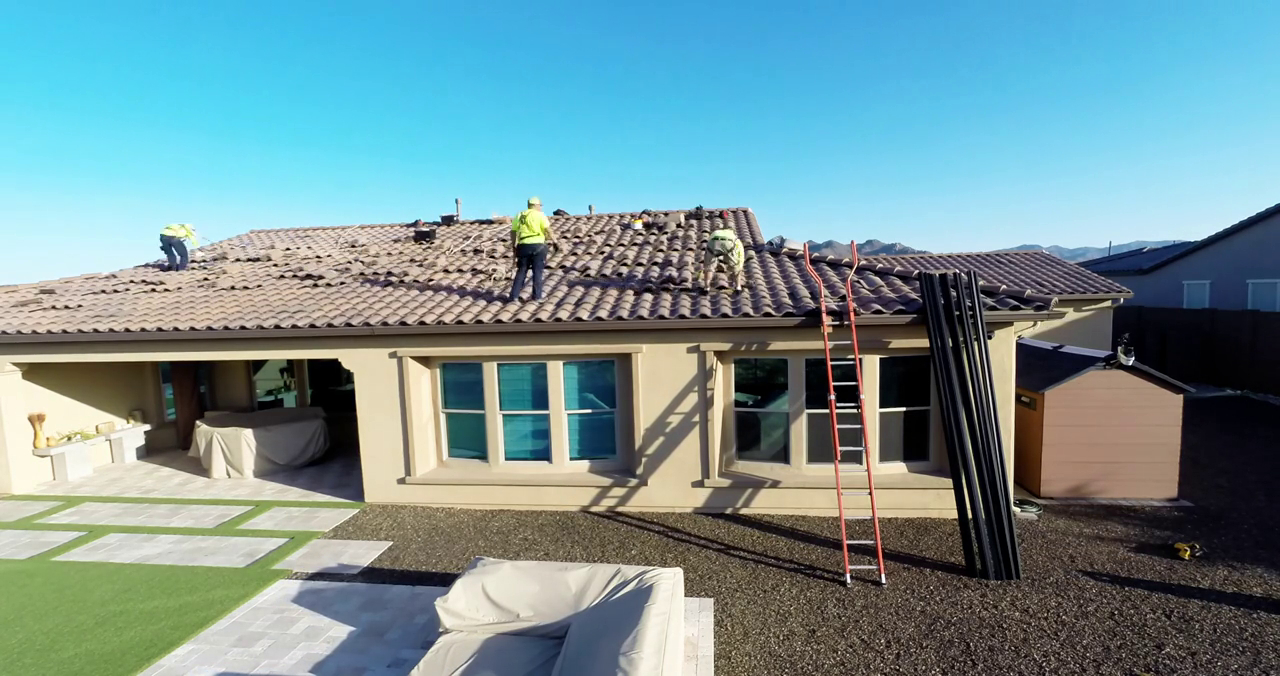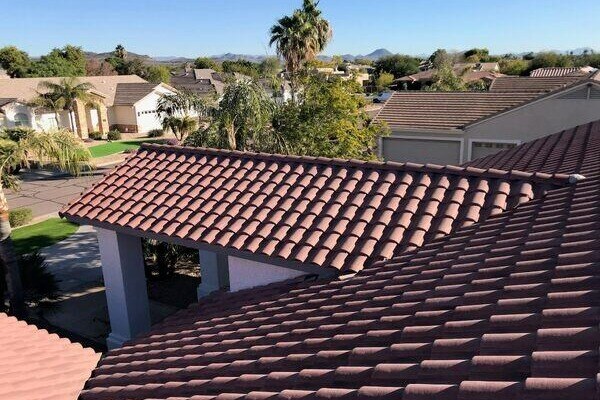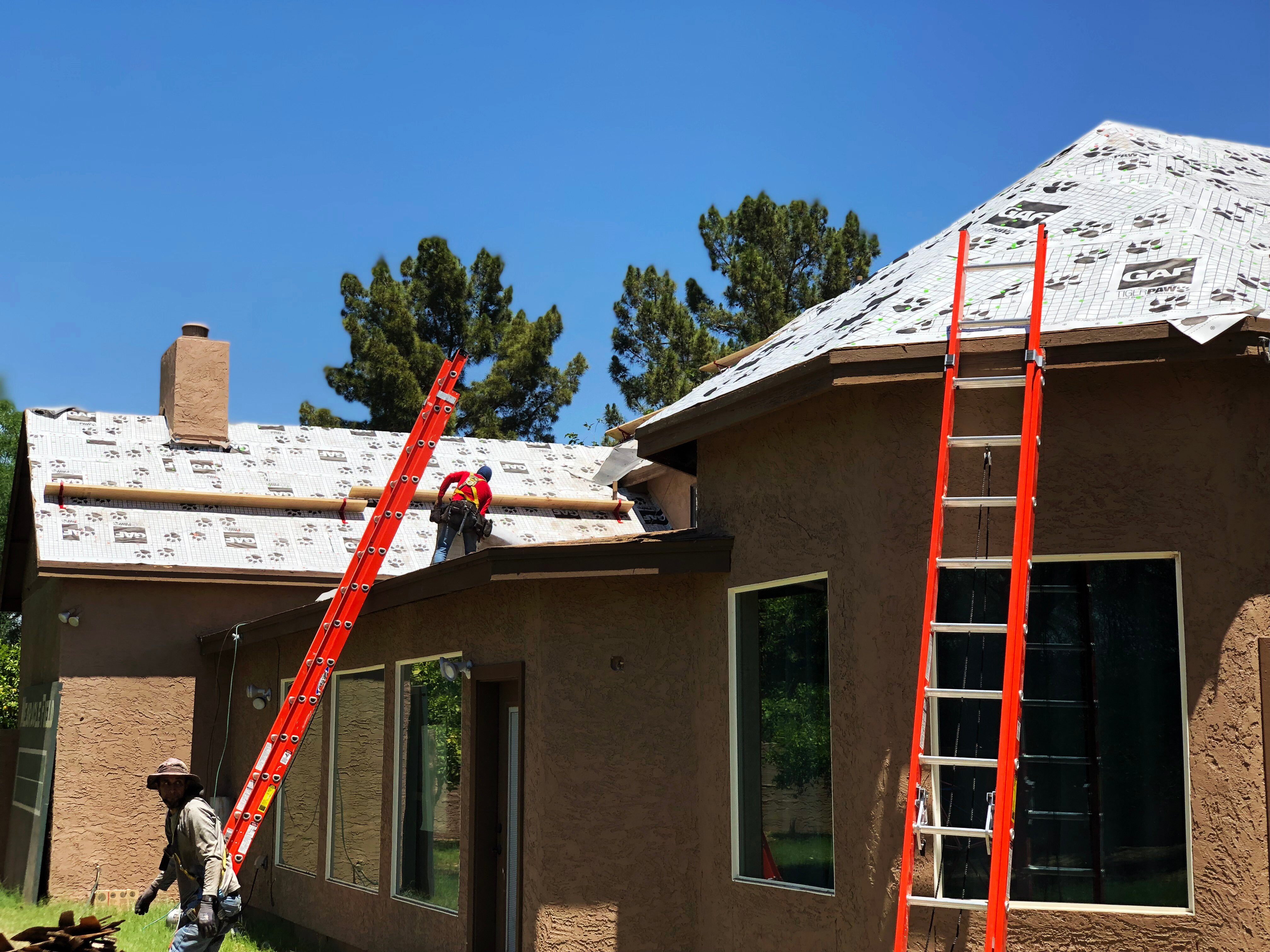Roof Underlayment 101: What It Is & Why It’s Important
Home / Azul Blog / Roof Underlayment 101: What It Is & Why It’s Important When most homeowners think about their roof, they picture the tiles, shingles, or foam that cover the top...
7 min read
Paul Hammons, Production Manager : June 13, 2025

In Arizona, choosing a roofing material is about more than just aesthetics. Our unique climate with its high summer temperatures, intense sunlight, and monsoon rains really puts roofing to the test, so thermal efficiency and protection against the elements are essential. The best roof types in Arizona are those that can reflect the heat, handle quick temperature swings, and stand up to harsh weather – while, of course, also looking great and fitting into your budget.
Whether you’re installing a new roof, updating a commercial property, or looking to replace an old, ageing roof, this guide will talk you through the most effective roofing options for Arizona’s desert climate. We explain different roof types, the pros and cons of each, and also outline some things to consider when choosing a roof material in Arizona.
Clay and concrete roof tiles are a classic in Arizona, and for good reason. These materials are designed to withstand the state’s intense heat, dry air, and seasonal monsoons, making them an excellent choice for both homes and businesses.
Concrete tiles are made from a mixture of cement, sand, and water that’s molded and cured to form heavy, durable tiles that can mimic the appearance of stone, wood shake, or traditional clay. Clay tiles are kiln-fired and known for their rich, natural color and classic Southwestern look.

Whether you choose concrete or clay, both types of tile offer:
The drawbacks of clay and concrete tiles include:
If your home or business has a flat or low-slope roof, spray polyurethane foam (SPF) is one of the most effective and energy-efficient roofing options available. These types of roofs are a popular choice for many commercial property owners in Arizona, and we’re seeing them become more common on residential homes too.
SPF is applied as a liquid and expands to form a solid, foam-like layer that fully adheres to the roof surface. This creates a continuous, waterproof barrier with no seams, which helps to prevent leaks – an important advantage during monsoon season.

The benefits of an SPF roofing system include:
Some of the drawbacks of installing a foam roof include:
Read: Which Type of Roofing Material Lasts the Longest in Arizona?
Metal roofing is an undoubtedly attractive roof type and becoming more popular for both commercial and residential properties in Arizona. This type of roofing material features vertical metal panels with raised seams that interlock above the roof’s surface. Metal roofs are usually made from aluminum or steel, but you can also find premium options in zinc or copper.

The advantages of metal roofs in Arizona include:
Some of the drawbacks of installing a metal roof include:
Asphalt shingles are versatile and cost-effective, making them a particularly common roofing material for residential homes. While they're not as heat-resistant as tile or metal, many modern asphalt shingles are built with reflective granules and improved adhesives to better withstand that intense Arizona sun.

Some of the benefits of installing an asphalt shingle roof are:
Some of the drawbacks of asphalt shingle roofing are:
Modified bitumen is a time-tested roofing material that combines asphalt with fiberglass or polyester reinforcements to create a tough and flexible membrane. It’s most commonly used on flat or low-slope commercial roofs.
Some of the advantages of modified bitumen roofs are:
Some of the drawbacks of modified bitumen roofing are:
See: Reasons to Prepare Your Roof Now for Monsoon Season in Arizona
If you’re interested in a more premium roofing material, slate is an excellent option. Slate is made from a natural stone and prized for its beautiful appearance and incredibly long lifespan – often exceeding 100 years when properly maintained.
The advantages of installing a slate roof include:
Some of the drawbacks of slate roofing include:
Thermoplastic polyolefin (TPO) is becoming one of the most popular roofing materials for flat and low-slope commercial roofs in Arizona, especially warehouses, retail centers, and office buildings. It’s designed for durability and offers a sleek and reflective surface that works well in our intense sun and heat.
The advantages of TPO roofing for commercial buildings include:
Some of the drawbacks of TPO roofs include:
Keep Reading: Replace vs Repair a Roof: Factors to Consider Before You Decide
The table below summarizes the roofing materials we’ve discussed in this article so you can understand their benefits and unique properties at a quick glance:
|
ROOFING MATERIAL |
BENEFITS |
LIFESPAN |
STYLE OPTIONS |
ENERGY EFFICIENCY |
COST |
|
Clay or concrete tile |
- Long lifespan - Fire-resistant - Excellent insulation |
50+ years |
Lots of colors + styles to choose from Mediterranean/Southwestern aesthetic appeal |
High |
High |
|
Spray polyurethane foam (SPF) |
- Seamless waterproofing - Lightweight - Excellent insulation - Easy installation |
20 - 30 years |
Limited to white + light-colors |
Very High |
Mid-Range |
|
Standing Seam Metal |
- Durable - Fire-resistant - Reflective - Low maintenance |
40 - 70 years |
Lots of colors + finishes to choose from Modern/Rustic aesthetic |
High |
High |
|
Asphalt Shingles |
- Affordable - Easy to install |
15 - 30 years |
Lots of colors + styles to choose from |
Moderate |
Low |
|
Modified Bitumen |
- Durable - Flexible - Can handle foot traffic |
20 - 30 years |
Limited options |
Moderate |
Mid-Range |
|
Slate |
- Extremely durable - Elegant with high curb appeal |
100+ years |
Classic, natural stone |
Moderate |
Very High |
|
Thermoplastic Polyolefin (TPO) |
- Affordable - UV-resistant - Mold resistant |
20 - 30 years |
Limited to commercial or flat roofs |
High |
Low to Mid-Range |
Choosing the right roofing material often requires a balance between cost, aesthetics, and long-term performance. But with Arizona’s extreme heat, intense sun, and occasional storms, you also need to choose a material that works with our state’s unique environment.
Here are some key factors to consider when choosing the right roofing material in Arizona:
Materials like clay tile, metal, and spray foam roofing offer the longest life and best thermal performance in Arizona’s heat and intense UV exposure. Look for options that offer strong wind, fire, and water resistance.
Energy-efficient roofing can make a significant difference in your monthly electric bill. Good energy-efficient roof types are reflective metal or insulating foam. If you’re a commercial property owner, energy efficiency can also help your business meet sustainability goals and boost brand reputation.
See: What is Low-E Insulation & is it Good for My Roof?

When considering costs, you want to think about your budget as well as the roof’s lifespan. For example, asphalt shingles are affordable but might need to be replaced more frequently. On the other hand, tile, foam, or metal roofs cost a bit more upfront but can last you 40 to 50 years or even more when properly maintained.
Of course, you’ll want to choose a roofing material that complements your home or building’s design. Tile offers a classic Southwestern look while metal gives a sleek and modern finish. This is all about personal preference.
Some roofing materials, like spray foam and TPO, are ideal for flat roofs, while others, like shingle or tile, are better suited for steeper sloped roofs.
Other things to consider when choosing roofing materials are:
If you’re not confident making this decision on your own, that’s what our team is here for. Our expert roofers at Azul Roofing Solutions are well-versed in Arizona’s unique climate and the needs of homeowners and businesses across the state. We can help you evaluate your property, budget, and considerations and suggest the best options for a roofing material that meets your needs.
Contact our team or call us on 480-689-5055 to discuss the best roofing option for your Arizona home or commercial property today.

Home / Azul Blog / Roof Underlayment 101: What It Is & Why It’s Important When most homeowners think about their roof, they picture the tiles, shingles, or foam that cover the top...